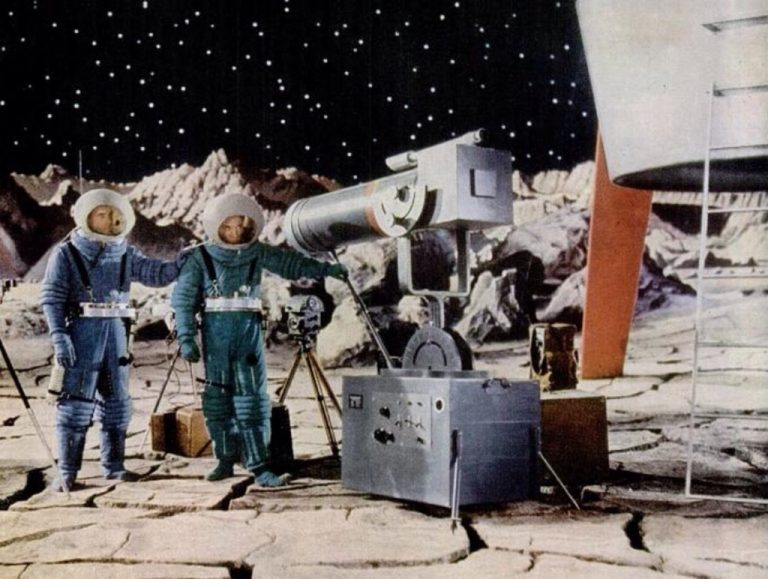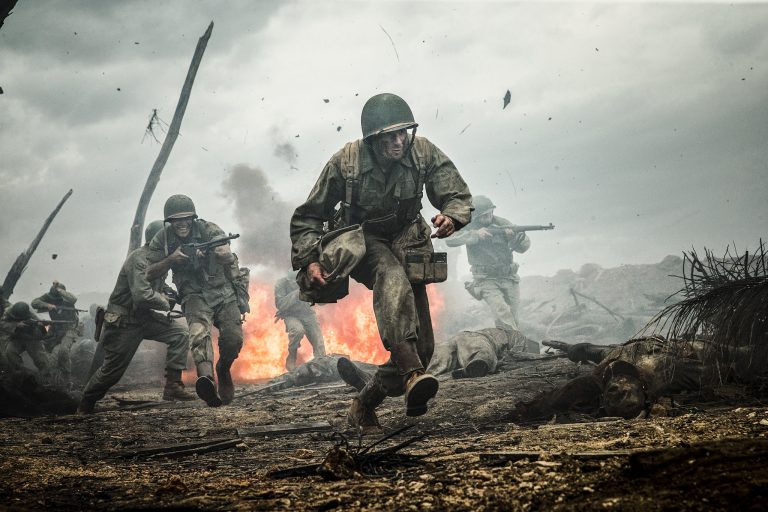Steven Spielberg is considered by many to be one of the greatest directors of all time. Experimenting with diverse genres ranging between horror, musicals, thrillers, and drama, Spielberg has done it all and still contributes creatively and logistically to improve the medium and craft of filmmaking. While he is known for inciting numerous ‘first-of-its-kind’ innovations in filmmaking and screen culture, perhaps no contribution surpasses his involvement in creating the summer blockbuster. The money-minting international sensation that Hollywood is today is credited mainly to the summer blockbuster, a larger-than-life action-filled genre predominantly catered for family audiences that requires limited cerebral investment but delivers maximum engrossment. Of the many summer blockbusters Spielberg has worked on, none is perhaps as groundbreaking as his third film, Jaws (1975).
Terrifying, gory, anxiety-inducing but fun nonetheless, Jaws amassed $100 million at the box office in 61 days, the first ever film to do so. It has been picked apart and examined in academic discussions for its marketing strategies, production culture, artistic nuance, and political subtext. What makes Jaws stand out is how it reimagined the horror genre by imbibing it with humour and charm whilst refraining from trenching into the realm of surrealism the genre is known for. So what does Jaws do differently that allows it to maintain its quirkiness while still terrorising its audience? How has Jaws, a film released nearly 50 years ago about a shark hunt, stood the test of time and stayed relevant even today? What innovative tactics have the film deployed to universalise the creature-feature genre? This essay will attempt to discuss these questions in depth.
The Legacy of Jaws
Jaws (1975) met with many positive reviews at the time of its release. Partly responsible for its astronomical commercial success was the heavy advertising surrounding the film, characterising it as a much-watch event. The fame of Peter Benchley’s novel, from which it was adapted, also played a massive role as it was just released the previous year and was a best-seller. Additionally, releasing an action-adventure film with a relatively straightforward plot during the summer holidays played a crucial role. Amassing three Academy Awards, including a nomination for Best Picture, Jaws was truly a trailblazer of its time. The culmination of these factors allowed the film to be the highest-grossing film of its time, only beaten by George Lucas’ Star Wars (1977), which came out two years later. Both these films cemented the creation of the post-classic, family-oriented ‘Summer Blockbuster.’
Critics initially praised Jaws for its technicality in animating the mechanical shark and the screenplay for anthropomorphising the Shark (from hereon, I shall be addressing the shark in the film as Shark) as cunning, calculated, and deviant. Parallely, audiences lauded the thrill, humour, and dread the film incited. Critic Nigel Morris also notes that the film received additional praise for its decision to stray away from the sexual subplot of the original novel and for reimagining it as a family entertainer instead of a gritty drama.
However, with the success of Jaws and the resulting change in filmmaking formula came criticism about how commerciality perverted the craft, resulting in a loss of aesthetic integrity or artistic nuance owing to formulaic blockbusters that dominated the box office. Peter Cowie observes that “While Time’s top 1975 films included Jaws, a number of leading reviewers considered it shallow, soulless, gratuitous, crammed with ‘clichés and one-dimensional characters”. These criticisms grew further as many scholars accused Spielberg of being manipulative by sentimentalising controversial plotlines with happy endings. Being the first ‘blockbuster’ of its kind at a time when film criticism was beginning to be imbibed into scholarly discourse, Raymond Haberski argues that Jaws provoked “interpretation by the first truly substantial generation of film scholars.” Contrary to public journalism, Jaws first had to be torn apart in academic discussion before it could develop any merit.
Consequently, Spielberg and Lucas were scrutinised for being the harbingers of New Hollywood’s downfall. According to J. Hoberman, by 1975, the ‘extraordinary indigenous avant-garde’ that was New Hollywood was done away with. Jaws and Star Wars spawned several sequels, establishing a market for franchise films, and rebranded cinema as a full-on market commodity due to its reliability and massive profits. These films increasingly became ‘critic-proof’ as the general value of films grew beyond their critic-assigned value, and audience reaction decided the future of a film or franchise. Morris claims that Jaws’ release campaign undermined the authority of film critics and reviewers. These shifts were important moments in film history as, not long ago, during the 1970s, critical approval and box-office remunerations were eerily complimentary of each other.
While sections of scholarship surrounding Jaws have narrowed down on its more extensive involvement in the erasure of New Hollywood and the development of new economic and financial models, other factions investigate the film’s social themes. For example, in his essay ‘Legacy of Jaws,’ while simultaneously pointing out the film’s reductive narrative, Nigel Morris deduces exciting observations on how the film reflects on issues such as Watergate, masculinity, and feminism-induced anxieties.
Additionally, later scholarly debates argue that Jaws did not, in fact, ‘invent the blockbuster’ nor develop the market model that radically commercialised the industry. In his essay ‘New Hollywood,’ Thomas Schatz puts forward the proposition that change was inevitable as increasing production costs demanded huge turnovers while audience turnouts did not happen as expected. These arguments are only supported by Peter Biskind’s claim that 1975 was a ‘watershed’ as many leading directors ‘went down in flames.’
One of the more interesting debates surrounding the film is the identity of the film itself. What genre does Jaws fit into? Did it establish a new genus of film culture? How would conventional categorisation bend itself to accommodate Jaws? As Spielberg puts it, is the film just “about a shark named Bruce”? What larger narratives does it draw from, and does it try to be a social commentary? The interpretation and reinterpretations of Jaws are numerous and are both synergetic and contradictory and only add to its ever-growing legacy.
For Stephen Heath, “Jaws is a Watergate film”. He claims it is a satire on the Watergate scandal, which involved the covering up of President Richard Nixon’s involvement in the June 1972 break-in of the Democratic National Committee headquarters in Washington, D.C., at the Watergate Office Building. The Shark may symbolise the raid on Watergate carried out against Nixon with Mayor Vaughn and his ignorant disapproval, symbolising Nixon’s resistance against accusations of his involvement in the scandal, ultimately leading to acceptance and defeat.
Heath, in his essay, ‘Jaws, Ideology and Film Theory,’ goes on to elucidate how Jaws can be both a commentary on the Vietnam War as well with the shark being the unnamed, mysterious other, the Vietcong, whom Brody and Hooper must annihilate. For Robert Torry, their mission is completely satisfied when Quint, the representation of the working class and embodiment of the values of the Vietcong, is dead. Heath also goes on to hint how Jaws is a ‘white male film’ that frequently hints at castration anxiety and alignments to subordinate women as viewers of action and objects to be admired.
Given all these thoughts into perspective, perhaps Roger Ebert summated it perfectly when he claimed that while Jaws may have multiple underlying subtexts, “Spielberg wisely decides not to underline any of them. . . . [N]one of the characters has to wade through speeches expounding on the significance of it all.”
So all these readings beg the question: is Jaws really about a “shark named Bruce”? And if it is beyond so, how has the film used its horror codes to bring out the surreality of its hidden narratives? Even more importantly, from an aesthetic and artistic perspective, How did Spielberg make audiences afraid of a shark that was not on screen for more than 10 minutes in a 2-hour film?
Recommended Read: Discovering Steven Spielberg’s Magic: Why The Fabelmans and Close Encounters of the Third Kind Should be a Double Bill
Setting the Scene
The audience is aware of the impending danger. They know it even before the film begins, with the massive promotion backing it. The promotion material makes it evident that a great white shark will haunt the beaches of Amity Island during the weeks leading up to the 4th of July. The film’s genre confirms there will be violence. The audience knows what the source is, the Shark, and how the attacks will happen from underwater. However, they do not know when the attack will happen. The anxiety that ensues incites the horror of Jaws.
Spielberg ensures that audiences are kept in the dark about when the attacks might occur by effectively making the Shark ‘invisible.’ What this means is not that it cannot be ‘seen,’ but more so that audiences cannot ‘see’ it as often as they would like to. How Spielberg shoots the ocean plays a vital role in this.
Any threat on land is visible. Its movement is detectable and, more importantly, predictable. However, with a water-borne threat, it presents uncharted territory for mammals and allows the threat (here, Shark) refuge any time it desires. The Shark, despite being the ‘hunted’ in the second half of the film, is only threatened if it chooses to let itself be threatened. This defuses any form of control the protagonists have over the situation.
In the first sequence, Spielberg shows the contrast in sight and understanding below and above water through the female swimmer who gets devoured. For a brief moment, the camera shows the threat underwater by showing the point-of-view of the Shark ogling at the dangling legs of its prey but later only shows the terror it results from above water. What happens below the surface is entirely unbeknownst and beyond comprehension. This single scene makes large water bodies a threat altogether, not merely as spaces of the unknown but as a source of danger to life.
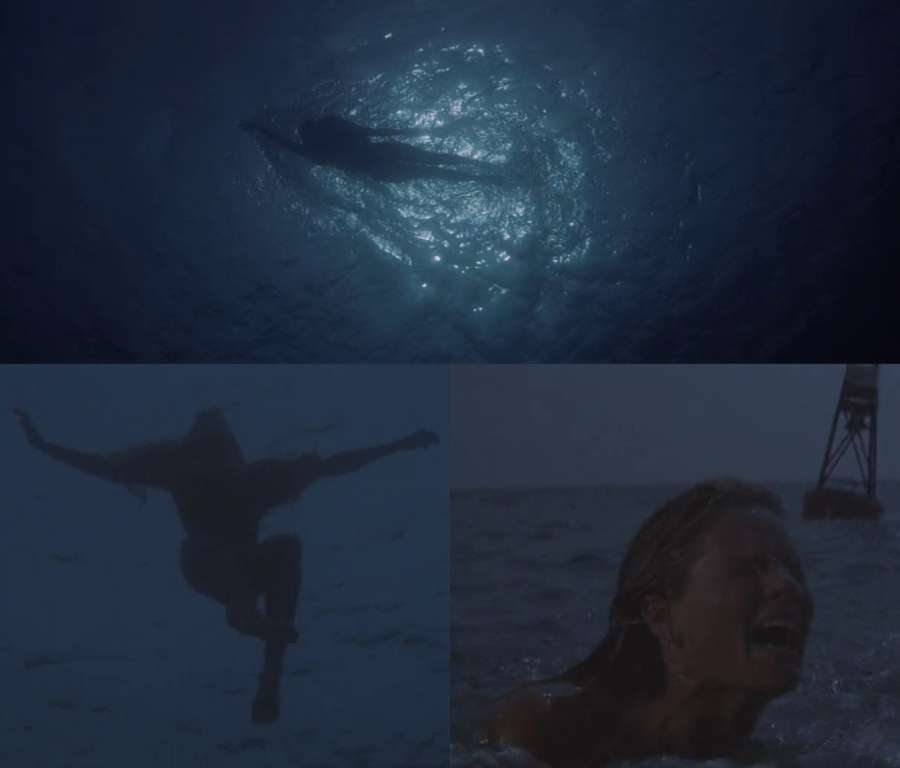
Another critical decision by Spielberg that elevates the horror of Jaws is his willingness to show harm to children on screen. Children are recurrently depicted in threatened spaces. After the central protagonist is introduced, the first attack is on a child, Alex. The film later shows Brody’s children on a boat docked by the beach. When Brody orders them to get on land and away from the boat, Ellen says the kids are safe since they are on a boat, so audiences feel reassured. However, upon seeing a picture of a shark attacking a boat in one of Brody’s guides, she orders them to come out.
During the attack on the 4th of July, the Shark attacks the estuary where the kids are playing, not the beach where there is far more prey. Brody’s children are immediately at the threat of the attack. Had audiences not witnessed Alex’s killing, they would not have felt the imminent threat the Shark posed to the children. But having witnessed Spielberg go to that extent, the thought of having to see another child murder, this too the child of the protagonist with whom audiences develop a strong connection, would have elevated the film’s grimness.
Spielberg also keeps the killing relatively low and invests efforts to elevate the shock value of each killing. Except for the first, all the other killings are meditated and stretched out, crescendoing with gory violence. This way, the gore is not nulled down and hermeneutically normalised by the audience due to frequent exposure to killings of the Shark, allowing the recreation of dread each time the background score plays, teasing an imminent attack.
Another key attribute worth diving into is the sound design of the film. Even in the absence of the Shark, John Williams’ Oscar-winning score personifies the dread radiating from the mechanical dead eyes of the Shark. A mixture of mellow, eerie, and daunting, the terror is communicated through the score that foreshadows the imminent attack of the Shark. Even while humans had the upper hand on land, the score remained predominantly pessimistic until the central character entered the sea.
When on the offense, at sea, in moments of teamwork and camaraderie between the three leads, there were rare spurts of background music filled with gusto and inspiration. Such instances proposed a turn in the tide of power as the men slowly began to learn from each other and conquer the sea and its many challenges. However, these were primarily short-lived. When the camera goes underwater, the audience gets the Shark’s POV, and the two-note score returns, crescendoing as the Shark moves ever closer to its target. The background score, in a way, navigates the audience’s emotions, controlling how and what they should feel in terms of horror.
Directing Action and Creating Tension
Framing plays a crucial role in inciting dread. The camera presents the sea as vast, lifeless, and endless. When directing water bodies at the beach, docks, or shipyard, the frame composition is filled with objects and characters. However, When viewing the singularity of an object, like a person or a boat, placed in the vastness of the sea, foreign to ideal living conditions, distant from civilisation, moving further away from the known to the unknown and possibly dangerous, one feels a sense of nothingness that is deeply personal, which may later develop into existential dread. On a more phenomenological note, the film also frames multiple kinds of toothed figures. There is, of course, the jaws of the Shark, which cause a stinging pain at the thought of it stabbing itself into flesh, plunging through tissue, and oozing blood. But there are other allusions as well.
Brody’s introductory scene features a sequence where his son runs into the kitchen with a bleeding hand and says a vampire did it. This seems to be a foreshadowing of the Shark itself as it, too, has lifeless eyes, carnivorous desires, and sharp teeth like the stereotypical vampire. Yet another frame presents a creative synthesis meaning; when the three-man-crew leave the docks in the hunt for the Shark, the camera shows them leaving from behind an upstairs window with the bones of a shark’s jaw as its frame symbolising their travel to the depths of the danger.
The film also relies on symbolism to initiate a sense of urgency within viewers. A recurrent example is the fin. The swimming cap of the older adult who is swimming during the scene mentioned above and the wooden fin made by the children as a prank all look similar to the Shark’s fin. These ‘fins’ are tools for deception, concerning both the viewer and characters on-screen, but they also embody the sinister and mechanical aura of the Shark’s fin as they cause distress. Seeing the fin means that violence is imminent. As Frederick Wasser puts it:
“Disaster movies favoured longer shots over close ups and psychologically motivated point of view, maximising the stars concurrently on-screen. Jaws , contrastingly, conveys experience of ‘anticipated and actual attacks’.”
By making the Shark ‘invisible’ and the sea a cover, Spielberg is able to develop tension by drawing out scenes and toying with audiences on who the next victim could be. Let us take the second shark attack for reference to elucidate. The scene shows a dog playing fetch with its owner on the beach while a lady, a couple, and a kid on a floating raft are all in the water. While the characters on-screen are unaware of the impending danger, viewers (and Brody) anticipate violence.
As the scene resumes, the audience aligns with Brody’s point of view. First, we see a black head near the lady, which could be the Shark, but it turns out to be an older adult using a swimming cap. Next, we see a girl screaming and instantly recognise the possibility of a shark attack but is diffused as it is her boyfriend playing a trick on her. Later, the dog Tippet is missing, and we assume the Shark got it. Upon establishing all these possibilities, we, as viewers, recognise the visual grammar of the scene and expect it to explode with a splurge of violence and blood. But the release is delayed.
The scene is further developed, and tension is built as we get a POV shot of the Shark moving underwater, observing the dangling legs, seemingly easier targets to attack. However, the boy on the raft, Alex, is attacked. Our conscience tells us that Alex has immunity from being attacked because:
- The other suspended bodies on water are easier targets for the Shark than Alex, who is on a raft and
- Alex is a child, and depicting violence on a young body in a film marketed as a family entertainer seems counter-productive.
But Alex is the victim! Through this scene, Spielberg both develops tension and subverts expectations by inflicting harm (and gruesome) on a child’s body, effectively establishing that no one is safe from both the wrath of the Shark and the auteur’s creative will.
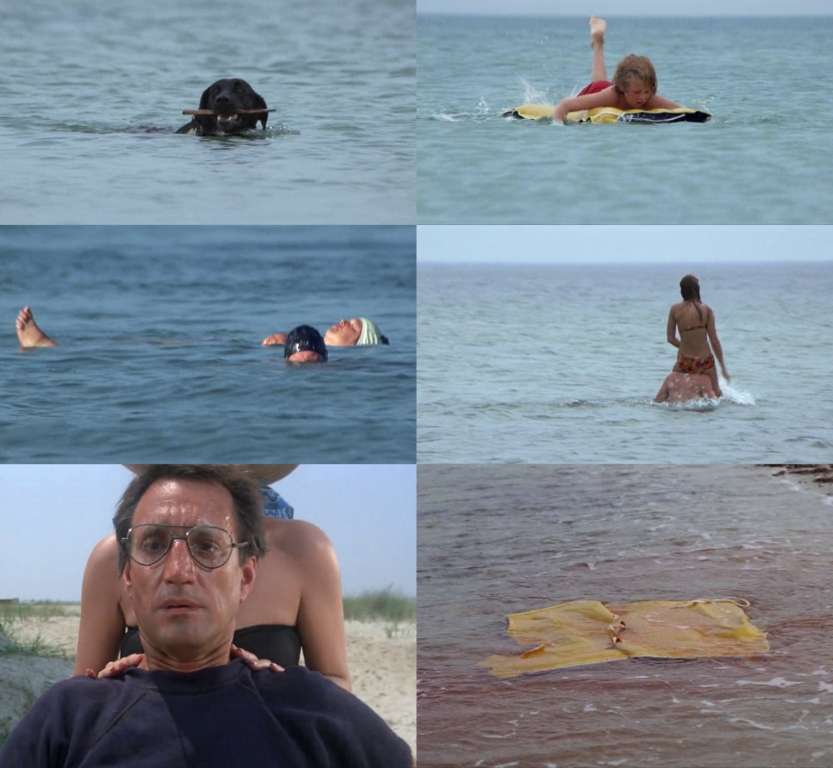
At other times, Spielberg gives no warning of the impending explosion of violence. For example, at the 1:21:20 hour mark, while an unsuspecting Brody is chumming, brooding all along on how insignificant he feels at his lack of seamanship skills, the Shark subtly surfaces its face. This catches both Brody and the audience completely off guard as it doesn’t come with the signs of danger like the fin, as mentioned before, or the eerie background music.
In another scene, around the 50:11 mark, when Hooper and Brody go out at night searching for the Shark, they come across a demolished boat. Upon inspecting the boat underwater, both Hooper and the audience are startled at a jump scare as the dead body of Ben Gardner pops up through a window of the boat with its eye popping out. Spielberg does not follow a fixed code, and therefore, audiences struggle with pattern recognition, failing to predict when or where the next scare will come from.
Developing Character and Developing Horror
For a creature feature like Jaws to terrify audiences, it is imperative that the source of terror be made larger than life. Man fears what he does not understand, and sharks are truly within the confines of his knowledge and, therefore, his power. This is where both the novel and film set the scene differently. The film manipulates the identity of its central characters, both animal and human so that both feel alien to audiences and, in turn, the characters amongst themselves.
Simply put, the Shark is made to be more beastly than previously understood by humanity, and the heroes are characterised as incompetent to take down the Shark on their own. Hence, there is a need for three central characters. I will elaborate on what role each character plays in ‘mythicising’ the shark to such proportions that it causes viewers to ask themselves if they truly understand the threat they face or question if the Shark is genuinely an average shark.
Let us first analyse the central protagonist, Officer Martin Brody. Brody was formerly a police officer in New York but now is one among less than ten officers on Amity Island. Contrary to New York, Amity is relatively uneventful; “In 25 years, there’s never been a shooting or murder in this town”, claims Brody at the film’s beginning. This could be a testimony to its high-income residents and tourism-centered neighborhood and is antithetical to the violence-ridden streets of New York City that Brody is familiar with.
Such a setting places Brody as the ‘other,’ a cop out of place, unused to slowed down life and unable to perform grand feats of heroics to earn the admiration of his town, absconding him of any respect or authority. This results in his repeated emasculation throughout the film. He is completely ignored when he tells visitors to get out of the water during the first attack.
Alfred Wilde belittles him for his fear of water. Later on, he is slapped by Mrs Kintner for not warning about the attack and is blamed for her son’s death, despite being the only individual who warned the mayor and the tourists of the Shark. He is repeatedly talked down to by the mayor and other authorities, by Quint, and even shouted at by Matt Hooper. His technical incapabilities further weigh him down; being a novice at seamanship, he cannot tie a knot, trips down incessantly on the boat, does not know how to handle equipment, and is deputed to chumming duty. All these factors make him considerably feeble, opposite the antagonist, the Shark.
Brody is not a character audiences typically feel secure with as a protagonist when facing a killing machine like a shark. For example, the Meg film franchise, a similar creature feature, is led by action star Jason Statham, who oozes the ethos of testosterone-induced ‘balls-to-wall’ action, everything Brody is not. Compared to him, Brody can barely keep his family safe, a central feature for American audiences in establishing a character’s reliability and masculine values.
Andrew Britton calls this the “utopianism of the new radical right,” which attempted to imbibe the “golden age in which the nation was great and the patriarchal family flourished in happy ignorance of the scourges of abortion and a soaring divorce rate, gay rights and the women’s movement.” By essentially weakening the protagonist who is supposed to carry the film, the film creates a sense of insecurity within audiences about how the action rises and magnifies the antagonist as a daunting challenge to overcome.
A similar argument can be made for Hooper. The film establishes Hooper as highly educated and well-off. He is updated on the latest marine technology and represents new blood, excited about making leaps and bounds in scientific discovery, optimistic in contributing to research, and presenting new scholarship. However, with his young age also comes a sense of immaturity. He tries to underplay Quint, who believes in traditional methods of seamanship and dismisses Hooper’s tech-savvy approach to fishing.
Conversely, he is frequently belittled by Quint, who claims he has “city hands” and that he has been “counting money [his] your whole life,” hinting at his lack of experience despite his knowledge about marine biology and further pointing out his upper-class privilege. His overzealous desire to make a name for himself in the scientific world sometimes jeopardises the greater good, as seen when he delays tying the knots on the barrels of Quint’s speargun. His obsessive desire to track and research the Shark by placing a tracker delays Quint’s opportunity for a headshot.
The confident, well-informed Hooper audiences are introduced to initially turn out to be an impulsive, rich, but spoiled pushover whose insecurity is made evident as he incessantly tries to establish dominance over Quint. Hooper’s attempt to document the shark reminds one of when Mayor Vaughn mocked him for wanting to go into National Geographic. It begs the question of whether taming the Shark is actually for the greater good of the public or for him to satiate his ego.
Compared to Brody and Hooper, audiences see Quint as a more reliable character to capture the Shark. Years of experience at sea, a stoic personality, and, ironically, a naive approach to danger make Quint a worthy opponent for the Shark. Even his boat is named ‘The Orca’, after a species of whale known to eat sharks and even other whales. However, Quint is visibly surprised and taken aback during his first encounter with the enemy. His successive attempts to both shoot the Shark and keep it afloat by anchoring it with barrels prove futile, and his reaction to the failed attempts suggests that he, too, is unfamiliar with the threat at sea. Added to his inability to tame the Shark, Quint’s belittlement of Hooper and Brody results in internal tension that causes much despite within the group.
As previously mentioned, Quint and Hooper are constantly at loggerheads against one another. They constantly debate around topics of modern and traditional ways of seafaring and class privilege. Quint is visibly annoyed with Brody’s emasculated personality and believes his wife to be the cause. For Quint, the sea is a hard place to be, and any feminine comfort weakens the heart. In Quint’s perspective, Ellen’ weakens’ Brody by catering to him, relaxing him – keeping him at bay from his heroic journey.
Quint doesn’t have a partner and instead collects ‘jaws.’ When Ellen calls Brody at sea, Quint takes the call but shares no update regarding the shark hunt. For him, such discussions do not concern women. Later, when Brody tries to contact land for support, Quint destroys the communication lines. He repudiates Brody’s feeble masculinity and wants to prove himself by doing it alone. He never wished to be assisted in the first place, now unable to tame the Shark despite working in a three-man drags his name in the mud.
While the three central characters as individuals prove to be incapable enough, all three together on the wrong page make things worse. The masculinity of the men is pinned against each other. While stranded in the sea at night, they compete by measuring battle scars. Brody proves to be the least grazed, despite being a cop in New York, while Quint has multiple wounds (and a traumatic war history), and Hooper has stingray and bull shark bites. These are their war symbols, their adventures as men against the world.
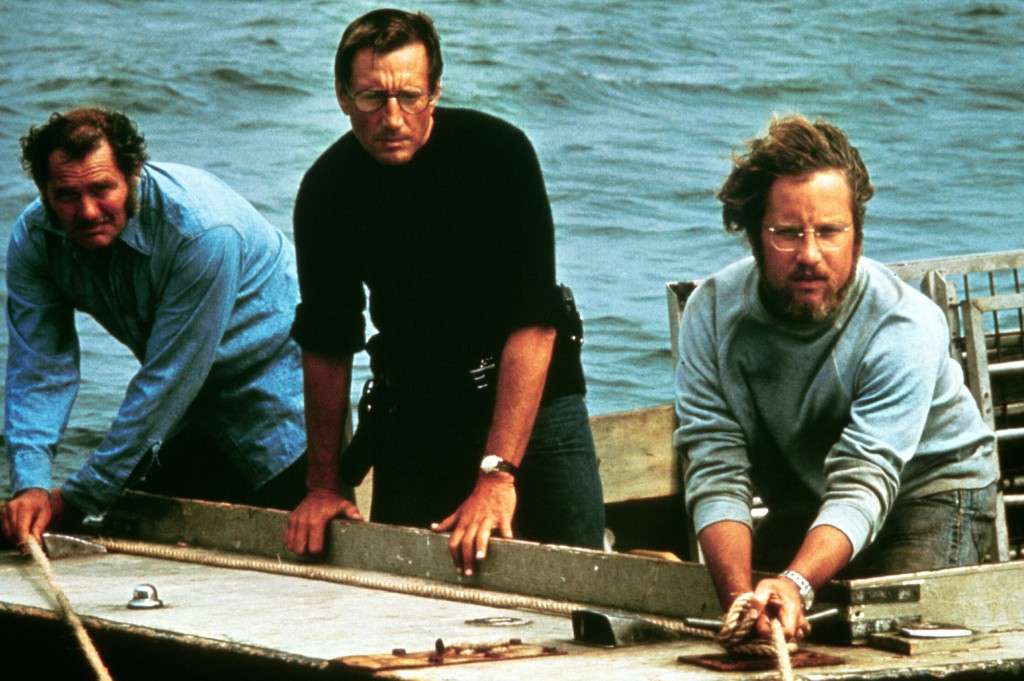
A different scene shows a shot-reverse shot of Quint drinking beer and crushing the can, cut to Hooper competing by drinking water and crushing a paper cup. At another time, Hooper gets mad at Brody for letting loose compressed air cylinders, and Hooper is mocked by Quint, asking what use it will be of. Ironically, it is those gas cylinders that Hooper brought and the shooting by Brody that kills the shark while Quint, the shark-catching veteran, is devoured by the Shark.
According to Frederick Jameson, Quint is the traditional representative of pre-capitalist times who must perish for contemporary traditionalists of capitalism to prevail. This is done by breaking down the single-hero-survivor into two: Brody and Hooper. Quint symbolises “small businesses’ decline, Yankee individualism, the New Deal and nostalgic patriotism,” while Hooper and Brody “unite contemporary ‘law-and-order’ with ‘technocracy’ Utopianism” by which Jameson means to proport the marriage between state authority and multinational capital against the industrial working-class. It can alternatively be symbolic of the death of an old breed, an individual who is against family values.
While bringing together these individuals is done to level the playing field, from the audience’s perspective, it elevates the threat the Shark poses. The film mythicises the Shark through its physical features and incredible strength. It is 25 feet long, pulls down three barrels, takes multiple bullets and spikes, eats down whole boats, and even mangles shark cages. The Shark is fast and, more importantly, intelligent. Both Hooper and Quint, who have experience studying and catching sharks, are amazed at the prowess of this one.
The Shark’s backstory, or the lack of it, further elevates its mythical identity. No one knows where it came from or why it suddenly decided to terrorise the beaches of Amity. The way Hooper talks about Shark characterises them as a mutated abnormality beyond the understanding of human comprehension or science. Also, as noted by Nigel Morris, the Shark’s ‘invisibility’ throughout the film results in different meanings and speculation being imposed on the Shark from viewers, further adding to its lore. The legacy of fear the Shark instilled with its rampant killing, size, and ferociousness lives on beyond its death.
Conclusion
As social beings, humans live with the innate optimism that their fellow beings will support them in their time of need. This comes from friends, family, acquaintances, local support bodies, and even the government. This trust and relationship genuinely give meaning to existence for a considerable majority. However, when this trust is damaged under pressure, an existential dread seeps in, leading us to ask ourselves the point of existing if our commitment to the other is not reciprocated to a minimum extent. Such existential dreads then become a source of internal horror as well. Jaws feature characters and, in turn, larger systems that contextualise this existential dread through their action and inaction.
On the surface, Jaws establishes capitalist greed as the thematic antagonist. However, one can read the film as a more profound commentary on capitalism as a source of horror and something that initiates the worst in man. A plain example of this would be through the character of Larry Vaughn, the mayor of Amity. He both ignores and manipulates news about the first shark attack, stating it was a boating accident. When the attack happens again, and Alex is killed, Brody is made to take up the blame even though Vaughn ordered the beaches to remain open against Brody’s orders.
Following the debacle, a shark hunt ensues, resulting in the capture of a tiger shark. Still, again, despite the expert opinion of Hooper that ‘this shark’ is not ‘their Shark,’ Vaughn continues to push the narrative that the Shark has been caught and peace has been restored to Amity. “Do whatever you have to to make the beaches safe, but they will be open,” says Vaughn, even after Brody and Hooper find evidence that the Shark is not yet dead when they come across the destroyed ship of Ben Gardner. On the 4th of July, when no one seems to be entering the water, Vaughn encourages tourists to swim and go into the water against public scepticism, resulting in another shark attack.
Despite his ignorance and narrow-minded goal for commercial profit, resulting in the death of many and communal traumas, the director presents Vaughn as a character worth the audience’s sympathy. Vaughn argues his actions were in the best interest of the town. He argues that he wasn’t presented with proof of a great white shark and didn’t act on it. Furthermore, Vaughn adds that his children were also on the beach when the attack happened. He justifies his stance of greed as if he has no other way out.
In truth, for Vaughn, the greater good of Amity means the greater good of its wealthy upper-class residents who own hotels, restaurants, luxury shops, etc. His actions are to appease individuals such as Mrs Taft, who claims at the town meeting, “I have a point of view, and I think it speaks for the many of the people here…Not only me because I have a motel”. Statements such as these make it evident that hypocrisy lies at the core of Amity’s upper-class underbelly.
Vaughn’s single goal is to please investors such as Mrs Taft, who care about their upper-class success and nothing else. This ensures greater funding for the town’s tourism, resulting in a higher pay grade for himself. His sentiments do not align with middle-class residents like Brody or working-class members like Quint. He is initially informed by the doctor who examined the girl that she was, in fact, a victim of a shark attack but later manipulated (and possibly bribed) the doctor into claiming it was a boating accident.
Despite a marine biologist like Hooper telling Vaughn that the shark the residents caught could not devour a whole human, he brushes aside the accusation and finally, on his plea citing that he endangered his children too, one sees an obvious narrative of children being the victims of capitalism. In the case of Alex’s death, Dan Rubey elucidates how blame is shifted to profit motivation, and Vaughn, who personifies villainy, is displaced and made into an unseen monster behind the drapes of capitalism. Through his imperative to provide for an elite few at the risk of hundreds of others, Vaughn represents the horror of capitalism that devours the fundamental right to life of the ordinary person.
What is more invigorating is that while Spielberg pushed enough to point out faults in the capitalist cog through characters like Vaughn and Mrs Taft, he essentially does nothing within the film to indicate any real change in the system. Vaughn’s plea for forgiveness ends as a plea and has no resolution. For all we know, he may have been stripped of his position as mayor following the debacle that happened on the beach, but in his place will come another individual, driven by capitalist greed, consumed with the thoughts of capitalising on the tourist attractions of Amity without a second thought to the lives that might be lost if a next Shark attack might ever occur. This presents another shade of the horror of Jaws and the current consumer-driven capitalist world itself.
Read More:
Revelation as Paradox: Oppenheimer and the Criticality of Scientific Reason
How ‘The Exorcist’ Established its Status as an Enduring Horror Classic
The Eerie and Fantastical Exhibition of Sam Raimi’s The Evil Dead Trilogy
References:
Andrew Britton, ‘Blissing Out: The Politics of Reaganite Entertainment,’ Movie, no. 31/32 (1986)
Dan Rubey, ‘The Jaws in the Mirror,’ Jump Cut, no. 10/11 (1976)
Fredric Jameson, ‘Reification and Utopia in Mass Culture,’ Social Text, 1 (Fall 1979); reprinted in Jameson, Signatures of the Visible (New York: Routledge, 1992).
Frederick Wasser, ‘The Cultural Context of Jaws (Foreword),’ Cinergie, il Cinema ele Altre Arti, Special Edition: Spielberg’s Jaws and the Disaster Film, No. 7 (March 2015)
Jane E. Caputi, ‘Jaws as Patriarchal Myth’, Journal of Popular Film 6, no. 4 (1978): 305-317
Hoberman, ‘1975–1985: Ten Years that Shook the World’, American Film (June 1985)
Nigel Morris. ‘In the teeth of criticism: Forty-five years of Jaws’. In Hunter, I. Q and Mathew Melia. The Jaws Book. (New York: Bloomsbury Academic,2020).
Peter Cowie, Eighty Years of Cinema ( South Brunswick: A.S. Barnes, 1977)
Peter Biskind, Easy Riders, Raging Bulls: How the Sex ‘n’ Drugs ‘n’ Rock ‘n’ Roll Generation Saved Hollywood. (London: Bloomsbury, 1998).
Raymond J. Haberski, Jr., ‘Sharks, Aliens, and Nazis: The Crisis of Film Criticism and the Rise of Steven Spielberg,’ in Nigel Morris, ed., A Companion to Steven Spielberg ( Boston: Wiley-Blackwell, 2017 ), 435–51.
Robert Torry, ‘Therapeutic Narrative: The Wild Bunch, Jaws and Vietnam,’ The Velvet Light Trap, 31 (Spring 1993).
Roger Ebert, 1975 (accessed 18 July 2023). The website anachronistically dates the review as 1 January 1975.
Stephen Heath, ‘Jaws, Ideology and Film Theory’, Times Higher Education Supplement (26 March 1976 ); reprinted in Bill Nichols, ed., Movies and Methods, vol. 2 ( Berkeley: University of California Press, 1985)
Thomas Schatz, ‘The New Hollywood,’ in Jim Collins, Hilary Radner and Ava Preacher Collins, eds., Film Theory Goes to the Movies ( New York: Routledge, 1993).
Thomas S. Frentz and Janice Hocker Rushing, ‘ Integrating Ideology and Archetype in Rhetorical Criticism, Part II: A Case Study of Jaws’, Quarterly Journal of Speech 79, no. 1 (1993)


